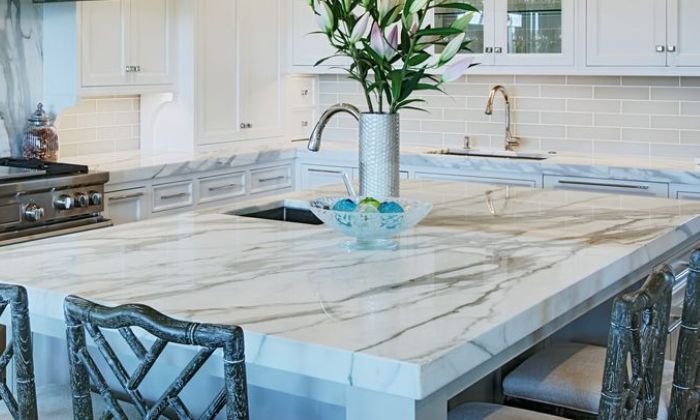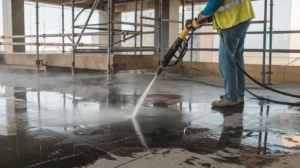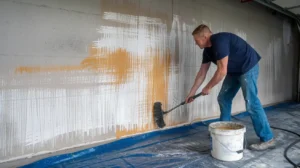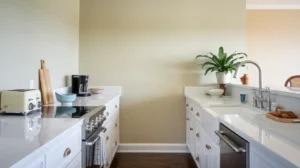When selecting the perfect surface for your kitchen or bathroom, marble vs granite countertops is a debate that frequently arises. Both materials are highly sought-after for their beauty and functionality, but which is better for your needs? In this guide, we’ll explore the major differences, weigh the pros and cons of each, and help you make the best choice for your home.

Marble vs. Granite Countertops: Major Differences
Appearance
Marble countertops are known for their timeless elegance, showcasing veining that ranges from subtle to dramatic, adding a luxurious touch to any space. Granite countertops, however, stand out with their unique speckled patterns and an extensive variety of colors and textures, making them versatile for different kitchen styles. If you prefer a sophisticated and classic appearance, marble is a perfect choice. Conversely, granite offers more options for those seeking diverse patterns and colors to match their design preferences. Both materials enhance kitchen aesthetics, but the decision depends on whether you prioritize marble’s elegance or granite’s versatility.
Water and Heat Resistance
Marble and granite are heat-resistant natural stones, ideal for countertops. Granite offers slightly better heat resistance compared to marble. Regarding water resistance, granite outperforms marble due to its lower porosity, making it less prone to water damage and staining. However, both materials require regular sealing to preserve their durability and maintain these protective properties. Proper care ensures their lasting beauty and functionality in kitchens or bathrooms.
Care and Cleaning
Marble countertops demand careful maintenance as they are vulnerable to stains from acidic substances like wine or citrus. Regular sealing and gentle cleaning are essential to maintain their elegance. On the other hand, granite countertops are more durable and easier to maintain. They resist stains and can handle harsher cleaning agents, though sealing is still advised to boost longevity. Marble’s delicate nature requires extra attention, while granite offers a more forgiving surface for everyday use. Both materials benefit from sealing to preserve their beauty and functionality, but granite is the more low-maintenance option for busy households.
Durability and Maintenance
Granite countertops are a top choice for durability, resisting scratches and cracks with ease, making them ideal for busy kitchens. In contrast, marble is softer and more prone to damage, including scratches and chips, especially in high-traffic areas. This difference in resilience makes granite a more practical option for long-term use. Additionally, granite requires less maintenance compared to marble, which needs regular sealing and careful handling to avoid stains and etches. If your priority is a countertop that can withstand daily wear and tear with minimal upkeep, granite outperforms marble, ensuring lasting functionality and beauty in your kitchen.
Cost
The cost of marble countertops vs granite countertops varies depending on the type of stone. Generally, marble is more expensive, with prices ranging from $50 to $250 per square foot. Granite, by comparison, ranges from $40 to $200 per square foot. If budget is a concern, granite is a more affordable option.
Lifespan
Granite and marble are both highly durable, but granite boasts a longer lifespan. With proper care, granite countertops can endure for over 100 years, making them an incredibly long-lasting choice. Marble, while also enduring for decades, is slightly less resilient and often requires more maintenance, including frequent repairs and refinishing. This makes granite a better option for those seeking minimal upkeep and maximum longevity. Both materials are excellent investments, but the durability of granite gives it a distinct advantage for long-term use in kitchens and other high-traffic areas. Proper maintenance is key to preserving the beauty of either stone.
Pros of Marble
Elegant vein patterns
Marble’s elegant veining is one of its most captivating features, making it a timeless choice for interiors. These natural patterns, formed by mineral deposits over centuries, create a luxurious and unique aesthetic that elevates any space. Each slab of marble is distinct, ensuring no two installations look the same. The intricate veins range from subtle wisps to bold streaks, complementing various design styles, from classic to modern. This combination of sophistication and individuality makes marble a favored material for countertops, flooring, and decor. Its unmatched beauty transforms ordinary spaces into stunning, artful environments filled with charm and refinement.
Lots of colors and styles
Marble offers a stunning variety of colors and styles to suit any design preference. From the timeless elegance of classic white Carrara marble to the dramatic appeal of bold black marble, there’s a perfect choice for every space. Lighter shades like beige or gray provide a subtle, sophisticated look, while vibrant green, pink, or blue marble can create unique, eye-catching accents. Each type of marble showcases natural veining patterns, adding character and depth to your surfaces. Whether aiming for a traditional or modern aesthetic, the diverse range of marble options ensures you can find the ideal match for your project.
Heat-resistant
Granite countertops are heat-resistant, making them an excellent choice for baking and cooking surfaces. They can withstand high temperatures without being damaged, ensuring durability and functionality in your kitchen. You can place hot pots, pans, or baking trays directly on the surface without worrying about burns or cracks. This heat tolerance makes granite particularly ideal for bakers, as the cool stone also aids in rolling dough. With its resilience and aesthetic appeal, granite combines practicality with style, providing a safe and reliable workspace for cooking enthusiasts while adding value and sophistication to your kitchen design.
Cons of Marble
More expensive
Marble typically costs more upfront than granite due to its unique appearance and the difficulty of quarrying and processing it. Marble is a natural stone known for its luxurious, polished look, which is highly sought after in high-end projects. The cost of marble can also be higher because it is more susceptible to damage and staining, requiring more maintenance over time. On the other hand, granite is more durable and resistant to scratches, heat, and stains, which can make it more affordable in terms of both installation and long-term upkeep. Despite its higher initial cost, marble adds significant value to any space.
Not as durable
Some materials are less durable and prone to damage over time. For example, surfaces like certain types of marble or softer stones can scratch and chip more easily compared to harder materials like granite or quartz. These imperfections can occur from everyday use, such as placing sharp objects on the surface or dropping heavy items. While these materials can be aesthetically appealing, their vulnerability to scratches and chips means they require more maintenance and care to keep them looking pristine. Homeowners must consider the trade-off between beauty and durability when choosing materials for countertops or flooring.
Susceptible to staining and scratches
Certain surfaces, such as marble and some granite types, are vulnerable to staining and scratching. Acidic substances like lemon juice, vinegar, and wine can etch the surface, leaving permanent marks. These materials also require careful handling to avoid scratches from sharp objects or rough use. Frequent exposure to spills, especially those with high acidity, can cause discoloration and surface degradation. Regular cleaning and immediate attention to spills are essential for maintaining their appearance. Additionally, using protective coatings or sealants can help reduce the risk of damage, though some surfaces still require extra care to avoid long-term harm.
Requires more maintenance
Certain materials, like marble and some types of granite, require more maintenance than others. To keep them looking their best and to prevent damage, regular sealing is essential. Sealing helps protect the surface from stains, scratches, and moisture. Additionally, these surfaces need careful cleaning, as harsh chemicals or abrasive scrubbing can cause damage. It’s important to use appropriate cleaning products and methods to preserve their appearance. Without proper care, these materials can lose their luster, develop stains, or even get etched, making ongoing maintenance crucial for long-term durability and aesthetic appeal.
Pros of Granite
Less expensive
Granite is a more affordable option compared to marble, making it an attractive choice for homeowners seeking high-quality countertops without breaking the bank. While marble is renowned for its luxurious appearance, it often comes with a higher price tag due to its rarity and the intricate processes involved in quarrying and finishing. Granite, on the other hand, is more readily available and easier to source, which contributes to its lower cost. Despite being budget-friendly, granite still provides durability, a variety of color options, and a sophisticated finish, making it an excellent value for those on a budget.
Lots of colors and styles
Granite comes in a vast range of colors and styles, offering homeowners a wide array of options to suit various tastes and design preferences. From bold, dramatic hues to subtle, neutral tones, granite’s versatility rivals that of marble, providing similar aesthetic diversity. Its color variations, including shades of black, white, gray, red, green, and blue, are often enhanced by natural veining and patterns. Whether you prefer a smooth, polished surface or a textured, matte finish, granite can complement any interior, making it a popular choice for countertops, floors, and other surfaces in modern and traditional settings.
Very durable
Granite is known for its exceptional durability, making it a popular choice for countertops and other surfaces. It is highly resistant to scratches, ensuring that it remains pristine even with daily use. Additionally, granite is tough against cracks, providing long-lasting strength without easily breaking or chipping. Its heat resistance is another major advantage, allowing it to withstand high temperatures without warping or sustaining damage. This combination of scratch, crack, and heat resistance makes granite an ideal material for kitchens, bathrooms, and other high-traffic areas, ensuring it maintains its appearance and functionality over time.
Less maintenance
Granite surfaces require minimal maintenance, making them a popular choice for kitchens and bathrooms. While granite needs to be sealed periodically to prevent staining, it is highly durable and can withstand heavy use. Unlike other materials, granite resists scratches, heat, and moisture, making it ideal for high-traffic areas. With proper sealing and routine care, granite surfaces maintain their appearance over time. The low maintenance requirements, combined with its ability to endure tough conditions, make granite a practical, long-lasting option for homeowners who seek both beauty and durability in their countertops and floors.
Cons of Granite
Composition varies in different slabs
The composition of natural stone slabs, such as granite or marble, can vary significantly from one slab to another. This means that the mineral content, color patterns, and texture may differ depending on the specific quarry or location where the stone is sourced. Even within the same type of stone, no two slabs are exactly alike. As a result, consistency can vary from slab to slab, leading to differences in appearance, veining, and overall aesthetic. This natural variation is part of what makes each stone unique and adds to the character of surfaces like countertops or flooring.
Potential to stain
While granite is less porous than some other natural stones, improper sealing can still allow liquids and oils to penetrate the surface, leading to stains. Granite countertops require regular sealing to maintain their resistance to moisture and contaminants. If the sealant is worn down or applied incorrectly, it creates microscopic gaps through which substances like wine, coffee, or oil can seep in, causing discoloration. Proper sealing ensures that the stone remains protected and retains its appearance over time, preventing the potential for stains and keeping the surface clean and easy to maintain. Regular maintenance is key to preserving granite countertops.
Susceptible to scratches
Although granite is a durable material, it is still susceptible to scratches. While it can withstand everyday wear and tear, sharp or heavy objects can leave marks on the surface over time. The hardness of granite helps prevent superficial damage, but it is not completely scratch-proof. To maintain its appearance, it’s important to use cutting boards, avoid dragging heavy objects, and clean up debris that could cause abrasions. Regular sealing can also help protect the stone, though it won’t eliminate the risk of scratches entirely. Proper care and maintenance can help reduce the chances of damage.
Granite or Marble – Which Is Better for a Home?
When choosing between granite and marble for your home, it’s important to weigh your priorities. Marble offers a luxurious aesthetic with its elegant veins and timeless appeal, making it a top choice for those seeking sophistication. However, granite is more durable and easier to maintain, making it ideal for high-traffic areas like kitchens. Its resilience against scratches and stains ensures it remains in top condition for longer. Additionally, your kitchen design and budget will influence your decision, as marble tends to be more expensive and may require more upkeep, while granite provides a more cost-effective and practical solution.
Conclusion
Choosing between marble vs granite countertops depends on your style preferences, lifestyle, and maintenance commitment. Marble offers timeless beauty but requires more care, while granite provides durability and affordability without sacrificing elegance. Both materials can transform your home into a stunning space.
FAQs
What lasts longer: marble or granite?
Granite lasts longer due to its superior durability. Properly maintained, it can last over a century, whereas marble may require frequent refinishing.
Which is more expensive: granite or quartz or marble?
Marble is generally the most expensive, followed by quartz, with granite being the most budget-friendly of the three.
Does marble scratch easier than granite?
Yes, marble is softer and more prone to scratches compared to granite.
Which is better: marble or granite for kitchen countertops?
Granite is better for kitchens that see heavy use due to its durability and resistance to stains. Marble is ideal for homes prioritizing luxury and aesthetics.
What is the downside of marble?
Marble is more expensive, less durable, and requires regular maintenance to prevent staining and scratching.





